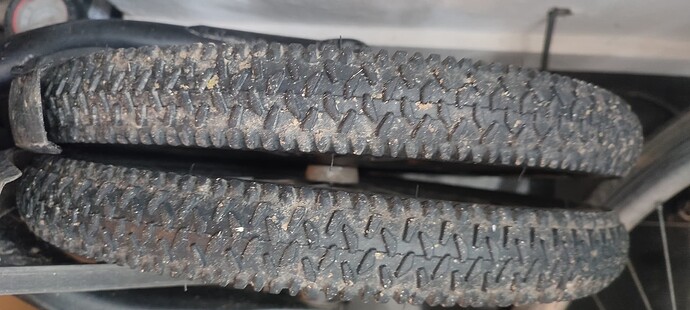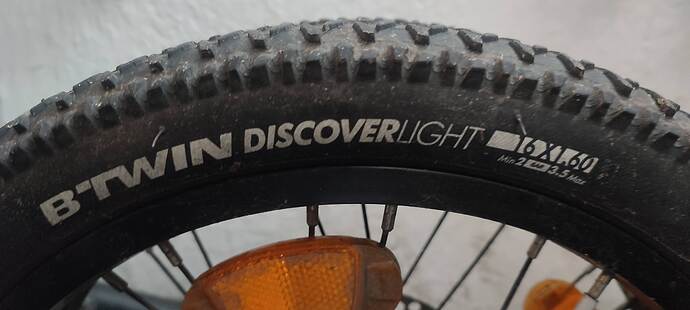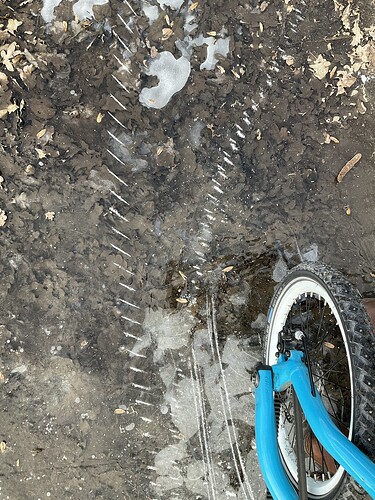Hi,
I saw in Strida manual it says it should not be used on ice. However, I saw a blog where strida was actually used on ice and snow.
Also I read a review for a guy from Finland who claimed using strida for one year without having any problem.
Do you have experience with using strida in freezing weather ?
I went yesterday for 30 min ride on snow and it was fun to ride Strida when it was -14 c ![]()
Hi,
if you mean our Finnish friend Markku; I believe during winter he paused riding regularly, maybe he wants to tell more by himself (?).
All I know about Strida and freezing weather is this:
The belt will get longer (not shorter!) and may possibly start slipping (but that happens very rarely).
Great to read that ![]()
As long as you feel good, go on ![]()
Hi,
I am fairly new to Stridas but not so new to riding bicycles.
It must have been some 45 Years ago that i rode my dutch bike across a frozen lake free handed.
I rode my Strida SX in Snow on Saturday and today. As shown in
Upgrade Your Strida: adjustable kick stand (Pic. 6) i even own winter tyres with spikes. This weekend, however, i rode the Strida on ordinary 40-355 18" tyres.
But to bring it down to Strida in general, i think that the QR seat molding kit is most essential.
When there is snow or ice, i get off of my Strida and bring the saddle down by two or three clicks. That way, my feet have a way better contact to the ground, should i slide on snow or ice.
I only ordered the 18" winter tyres (42-355) after i had tested 44-355 tyres so i thought the winter tyres should fit into the unmodified frame/wheels of the Strida like the 44-355 do (ever so close, but they do fit on Your lucky day). It turned out to be wrong.
42-355 winter tyres with spikes do need quite some modification of Your 18" Strida. Tomorrow i hope to get me a 16" Striida LT and may i notice, that -305 and -355 winter tyres with spikes are both discontinued by Schwalbe. Both, however, are still available in the market. As there are 40-305 winter tyres with spikes that should readily fit into the Strida LT and fenders, my recomendation is to
a) Modify a set of wheels and custom design a set of fenders compatible to the 42-355 winter tyres. It’s a challenge, bit i’ll do it.
b) Just get Yourself a set of 40-305 winter tyres with spikes for 16" wheels as long as they are still available.
It’s Heather of bromptoning.com, who purchased a Strida Evo for her winter bike.
And it will be my winter bike as i use the 18" Strida with the spikes tyres i purchased to give spikes tyres a try in winter times before i consider purchasing spikes winter tyres for one of my dutch bikes. The reason is simple: My Strida SX 18" has a QR seat post so i can stop and bring down my saddle by an inch or so on slippery grounds in just a few seconds.
regards: Klaus
Thanks nice bike and upgrade ![]()
Good point about lowering the seat to get closer to the ground.
Yes it is Heather. I think she rode her Strida without spikes. I noticed from her videos that there were not that much snow in Toronto at that time. In my opinion riding EVO become risky and unstable on fresh snow as the thickness increases. Actually any patches of fresh snow could make the bike shaky.
Hi,
who is experienced in snow knows, how hard it can be to keep up a speed of only 15 kilometers per hour in thick wet snow.
Heavy winter conditions and the rider that doesn’t have to disengage their bike is the winner of the day.
I don’t think that Heather is an exeptional “technical” bicyclist. She never wrote about winter tyres or anything like it.
Get down Your feet and if need should be, get Yoursef more grip, that is spikes tyres.
regards: Klaus
Hi,
another day, another impression.
Yesterday i had two short tours on my large and heavy Dutch bike. I slided in the ice twice and i crashed my bike onto the pavement once. Once i was able to hold it upright to stand still.
But i went several kilometers on all kinds of snow and ice today on the 16" Strida. I must have slided several dozends of times and eventually had to set a foot onthe ground to keep everything under control.
Guess, what my new winter bike looks like?
a) tall heavy unforgiving Dutch bike?
b) lightweight and small Strida?
c) not so sure about it?
Today it would have been perfect conditions (all kinds of snow/ice/wet road) for testing spikes tyres but i’ll have to wait for that, still. A 2nd 18" wheelset i on order and i’ll only modify a set of wheels (or two…) after having checked the production tolerances beforehand.
That means something to me as it is so ridiculously close with the convenient 44-355.
regards: Klaus
The answer is b) and c) ![]() .
.
Maybe this could help non-slip tie https://www.amazon.de/Reusable-Motorcycles-Anti-Slip-Emergency-Universal/dp/B0CP1R1W97/ref=mp_s_a_1_7?crid=1BJFHQGCD26ZV&keywords=Non-Slip+Cable+Ties+bike&qid=1702018910&sprefix=non-slip+cable+ties+bike%2Caps%2C161&sr=8-7
Doesn’t look like a reliable solution though ![]()
Exactly! And how much traction would such a plastic device (should it not have flown off after a first several hundreds of meters) have on asphalt?
Our Stridas have very limited space between tyres and fenders. Such a solution does not fit.
And You’d go without fenders in winter times when conditions change between wet and icy every few hundred meters or every few hours? I’d certainly not.
regards: Klaus
I recently used my Strida MAS again on snow.
I am using tires I bought from Decathlon which are a more suited for snow imho.
And of course I always stay vigilant as there will be slips. So always ready to put my feet down.
Hi,
a short description of those tyres would be nice. Brand, model, size … something that enables us to find the tyres, You talk about.
regards: Klaus
Sure, Klaus!
I will attach pics. Like I said they are much much better for this weather than the normal tires I got with the bike. You can find tubes for these at Decathlon as well.
BTW, I believe that generally tubes that are not fully inflated also work.
Hi,
for the moment being, i don’t have any riding experience with studded (spikes) tyres but i’ll give You 4 links that convinced me to go for winter tyres with spikes. Studded winter tyres, respectively:
- Transform your winter bike riding with studded tires!
- Piggdekktest Schwalbe Studded bicycle tires Ice Spiker Pro
- Are Studded Tires Worth It?
- Schwalbe Marathon Winter Plus test on frozen ponds
You find many other reviews but the general message is, that studded tyres are a gamechanger on ice and hard packed snow.
As i had mentioned above, i consider the Strida with a QR seat post a very reasonable platform for Your winter bike. Schwalbe, the manufacturer of my studded winter tyres, recommend that You best have two bikes to switch between according to the weather conditions. That’s exactly why i went for my second Strida. Even though changing tyres is comparably easy on the Strida, it’s still a job to do and if You can have a second Strida, prepare one with studded tyres, the other with conventional tyres. Then, it’s but a look out of the window, which of the two to choose.
My 42-355 Schwalbe winter do not fit to the 18" (or 16") Strida as is. The tyres are 40,5 mm wide and collide with the frame unless You shift the rims of Your bike several millimeters away from the frame.
Sounds difficult?
No, it isn’t. It’s something everyone can do.
I gave it 1/4 of a rotation to the loose side for each spoke on the frame side and 1/4 of a rotation for each spoke to the stiff side on the opposite side of the wheel. Everyone can do this and it made my 42-355 winter tyres fit into my Strida. As we talk about modifications in the range of serial production tolerances, You might have to do a bit less (nothing maybe?) or more to make everything fit. Still it’s a fairly easy job to do.
Pic. 1: 228 spikes waiting for the next ice to come.
Take a close look! One wheel has 4 rows of spikes, 152 spikes that is, and the other only has 2 rows of spikes, that is 76 spikes.
Schwalbe produces 2 similar ranges of winter tyres. The “Winter” model with 2 rows of spikes and holes for 2 more rows on the outer parts of the tyre. This “Schwalbe Winter” has a medium performance puncture protetction.
The other range will be the “Marathon Winter Plus” with a high grade puncture protection and 4 rows of spikes.
As the 30-305 Schwalbe Winter (the ones matching the 16" Strida) and the 42-355 Schwalbe Winter (the ones matching the 18" Strida) are discontinued, i found a set of “Schwalbe Winter” in the market and ordered a spikes-tool and additional spikes.
Pic. 2: This is not fun!
Adding spikes to Your tyre is tough work and not fun at all. A shoemaker’s tool (a tripod, that is) could be a good idea to make it a bit easier to apply the necessary force. However, i added 2 rows of spikes to the front wheel.
Very simple: If i could choose between one front wheel slide and 100 rear wheel slides, i’d certainly choose 100 back wheel slides.
Where a sliding back wheel is mostly easy to catch with a foot on the ground, a sliding front wheel can give You a nasty fall on Your wrists, shoulders or even on Your head.
So i chose to build in some selectivity between the front wheel and the back wheel.
I’ll have to wait and find out, how it feels with this configuration.
However, one thing is clear: The small and lightweight Strida - especially with a quick release seat post - is a brilliant winter platform and so i am looking forward to try out the studded wheels, next time we have icy conditions.
One remark though: the 42-355 do not fit under the fenders. Whatever tyres larger than 32-355 (or larger than 47-305 on a 16" Strida) will not fit to the bike. On a 16" Strida, You might be able to switch to 18" fenders, but the fenders seem to be in the way with larger wheels whatever You do.
30-305 should fit to the 16" Strida, though, so from this point of view, the 16" Strida appeares to be THE winter bike.
regards: Klaus
Thanks good post.
The spokes adjusting idea seem really clever ![]() . If I understood correctly, this adjustment make some tolerance between the tire and the frame?
. If I understood correctly, this adjustment make some tolerance between the tire and the frame?
Yes. Loosening the spokes on the frame-side and tightening them on the opposite side moves the rim and tyres away from the frame tube.
As it is only a matter of several milimeters, i don’t see a major problem with that.
regards: Klaus
Agree.
Any other bike would start to “pull” to one side.
On Strida, one can feel nothing ![]()
Hello,
Monday I had the first experiences with spikes tyres on ice. But I was in a hurry so no pictures were taken.
Today I found more puddles frozen to compact ice. Large enough to take tests and be able to show results.
Pic. 1: Only the spikes provide any significant grip on compact ice
It‘s not revolutionary how much (how little, actually) grip You have on compact ice. However, with spikes, at least You do have some noticeable grip.
It feels quite safe and comfortable if You keep within reasonable limits. It‘s as far away from ice speedway as night‘s darkness is far away from day‘s light. But once more: You do have some grip and this alone makes a vast difference.
You wish to ride smooth and careful. Don‘t lean into curves more than, let‘s say, 10 degrees.
You don‘t wish to rush into crossings, as the deceleration You can achieve is like 1/5 of what You are used to on a dry road.
Ride carefully and You can feel safe. You can‘t do that without studded tyres.
It‘s a vast difference.
Pic. 2: tells a story that I‘ll try to put in less than 1000 words!
Pic. 2 shows two traces. First there is the continuous lines in the lower part of pic. 2 that resulted from braking with blocked front- and backwheels
You see the outer trace of the front wheel and the inner trace ( more to the right ) of the back wheel.
The fact that the radius of the the back wheels trace gets smaller in the lowest parts of pic. 2 shows, that I remained in control. I was going from top of pic. 2 to bottom.
Yes, wheels block easily even with spikes. Once more: You do have some very noticable grip though, so spikes are a real game changer concerning winter safety.
The dottet traces are way more interesting. I was going from the bottom to the top of pic. 2 and so I was leaning into a moderate right turn.
The left trace (outer trace ) is the one of the back wheel. The right trace ( inner trace ) is the one of the front wheel.
4 rows of spikes in the front tyre produce more scratches than the 2 rows of spikes in the rear tyre.
It‘s a significant slide and so I was at the fringe of going out of control here. But take a closer look:
The scratches of the front wheel grow longer in the lower part of pic.2 and shorter in the upper part of pic. 2.
This means, that I had a massive ( more than only noticeable) slide of the front wheel in the center part of pic. 2 but still was able to catch it and regain control.
The rear wheel slides way more extreme as 2 rows of spikes do not provide as much grip as 4 rows do. Hence, the scratches of the rear wheels are much longer as compared to those of the front wheel.
The significant distance between front and rear wheel‘s traces show, what a massive drift that actually was. The sliding backwheel helped a lot with catching the front wheel.
I might have put a foot down on the ground to support the drifting bike, but no fall.
One last time: No it‘s not a race bike on ice, but that‘s not what I am looking for in the first place.
What I am looking for is some minimum amount of safety while riding to where I have to go.
Studded tyres do exactly that.
Strongly recommended.
And: Yes, the Strida with studded tyres seems to be the ultimative winter bike.
At least, it‘s my winter bike now and I won‘t change the configuration.
You might wish to chose between more grip ( 4 rows of spikes in the rear wheel) and more selectivity ( 4 rows of spikes in the front, 2 rows of spikes in the rear ). I‘ll keep it like it is as I am very satisfied with the selectivity that makes the rear wheel drift more than the front wheel.
Regards: Klaus
Hi,
one more time …
We have lots of difficult or even dangerous conditions these days.
A whole lot of new experience.
Pic. 1: whole roads of frozen wheeltracks
It’s not easy or safe to walk this road. A neighbour passed by carefully considering every 20 cm step she took. But i can easily and safely ride there with my Strida and studded tyres with spikes.
What a gamechanger these spikes are!
Using my experience i asked myself whether to purchase spikes tyres for one of my large bikes, too. But … No! Not if i don’t need to.
I’ll purchase a second set of 42-355 for my Stridas.
The Stridas are lightweight bikes with a quick release seat hight adjustment and a monostay in front and back that makes changing tyres as easy as it can get.
As i change bikes according to the weather and street conditions, i’ll only be on spikes like approximately 10 or 20 days a year. The tyres will last me a lifetime. But just to play it safe…
And: Yes! I’ll stay with 2 rows of spikes in the rear wheel and 4 in the front wheel.
I gave it a moment of concideration as some riders argue, You can adjust the grip on ice by changing the air pressure in the tyres (lower pressure - more grip, higher pressure - less grip).
However, i’m fine with my setup. I’m perfectly happy as it is.
I don’t see how i could further improve my situation on icy roads.
Once more: Strida is about the most perfect winter bike.
regards: Klaus
Hi,
@KWie
what kind of spoke wrench (in mm) you used for your tire?
It seems yours is not EVO. I read that EVO gear get stuck with snow. Also it is discontinued by manufacturer. So maybe EVO is not the ultimate winter bike. I am planning to try winter tires here as you suggested ![]()
![]() . The good thing here is that when it snows, it last for the whole winter mostly
. The good thing here is that when it snows, it last for the whole winter mostly ![]()
Regards,






